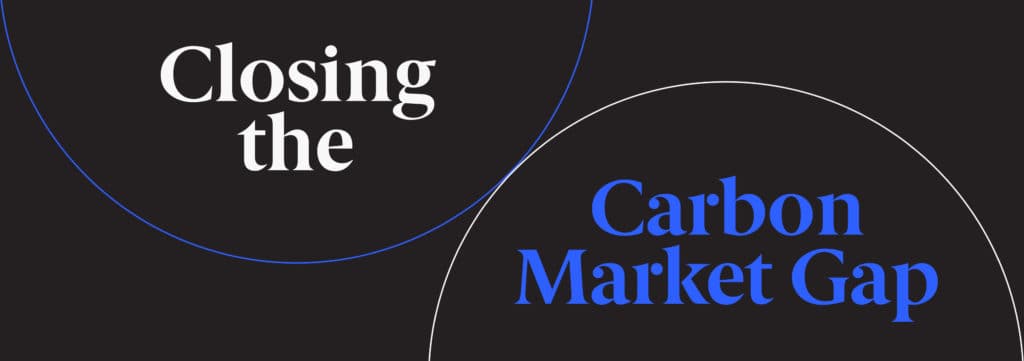Sustainability Software vs. Spreadsheets


Closing the Carbon Market Gap
According to Bank of America, carbon offset supply may need to grow as much as 50x by 2050 to achieve net-zero emissions. Watch the replay as three experts discuss efforts to close this gap and the challenges in developing projects and issuing credits at scale.
Sustainability software can help you quantify your carbon emissions, but you still need expertise to get it right.
Maybe you’ve made plans to calculate your carbon footprint for the first time, or perhaps you’ve already been quantifying your greenhouse gas (GHG) emissions for years and have ongoing sustainability reporting efforts, but you’re wondering if there’s a shortcut or an easy button. In recent years, an increasing number of Environmental Health and Safety (EHS) and Environmental Social and Governance (ESG) software solutions have hit the market that measure and report on GHG emissions and track sustainability metrics year over year. These software solutions are growing in popularity, partly due to their perceived simplicity—you give the system operating data, and it gives you your annual carbon footprint, right? But is it that simple? And more importantly, in the case of sustainability reporting, whether you’re reporting voluntarily or under a regulatory schema, are the results accurate?
Benefits of EHS & ESG Software Solutions
Here are some of the things that can make sustainability software solutions appealing:
- Data is tracked in a centralized spot.
- It makes it easy to compare results from year to year with dashboards and reporting functionality.
- The math is done for you once you enter your data.
- If all facilities in an organization are using the same software, software can allow for an easier roll-up of totals and tracking of metrics.
- EHS and ESG software solutions may integrate with other implemented solutions across your enterprise, inclusive of data analytics tools such as Tableau.






Quality In = Quality Out
Depending on the complexity of your operations, your carbon calculations across Scopes 1, 2, and 3 may include numerous emissions sources, including heaters and boilers, electricity consumption, supply chain emissions, fleet vehicles, corporate travel, remote work—each of these calculations has a number of inputs such as operational data, equipment data, emission factors, and unit conversions.
Gathering the data and generating calculations accurately and consistently year over year requires time and effort, whether you are doing the calculations in-house or with the support of a third party. If the data going into the EHS software is not accurate or up to date, the results of the calculations will also not be accurate. Users must have the expertise necessary to produce accurate results by using EHS software.
The necessary expertise can be in the form of an internal subject matter expert or an external organization like CarbonBetter, which can provide fractional expertise that is paid for only when needed to deliver accurate and consistent results and can work in partnership with internal resources. This type of engagement also has the added benefit of third-party verification, which adds credibility to the results.
“When quantifying emissions, it is important to do so in a traceable and transparent way so that the math can be easily validated and accurately repeated year over year. Software solutions are sometimes a black box, with math that is hard to trace and assumptions that are not well documented.”
Nicole Sullivan on Sustainability Reporting Software
EHS Software Implementation Considerations
EHS software solutions aren’t always as easy to implement or as accurate as one would hope. In addition, some of the features that might be most appealing about a software solution are not always available for use “out of the box” or as purchased. Often, software solutions require configuration and customization to meet the needs of a specific business.
When quantifying emissions, it is important to do so in a traceable and transparent way so that the math can be easily validated and accurately repeated year over year. Software solutions are sometimes a black box, with math that is hard to trace and assumptions that are not well documented.
More tailored solutions, which may be needed to capture complex supply chain emissions and industry-specific emissions sources, can be hard to configure to capture all calculation methodologies. Emission factors can change year over year, and new methodologies may need to be added to account for new emissions sources. Your software implementation is unlikely to be static, with annual reviews and updates being required. It’s not a set-it-and-forget-it solution, as it may seem.
EHS Software vs. Spreadsheets (& How CarbonBetter Can Help)
Below is a summary of what different tools can do and where a 3rd-party like CarbonBetter may add value, whether you’re using software or spreadsheets.
| EHS Software | Spreadsheets | CarbonBetter | |
|---|---|---|---|
| Data gathering | Data gathering is typically done outside of the system, with data then being imported into the software in specific formats. However, some software solutions may integrate with certain data sources, such as utility data. | Data gathering can be done utilizing spreadsheets. Some data sources may need to be transcribed from other formats into a spreadsheet. | Data gathering is often a collaborative effort across many stakeholders. We can support you in developing questionnaires, identifying all data needs, requesting and compiling data, and ensuring accuracy, consistency, and documentation. |
| EHS data management over time | Software systems will typically store data year over year, depending on storage plans. | Typically utilize a new spreadsheet version each year and save historical files. | Regardless of approach, maintaining historical data and results is important. CarbonBetter helps ensure sources are tracked and documented for accuracy and consistency. |
| Compare annual results year over year | Software tools often include a metrics component or reporting to trend results over time, but the utility is tied to accuracy and consistency in the data used each year. | A spreadsheet can be utilized to compare annual results. | Being able to track progress toward your goals and targets is important. We help our clients compare results annually as they work towards their decarbonization targets using formats that are right for their business. |
| Does the math for you once you enter your data | Once software is configured properly and the correct data is loaded, the system will generate calculation results. However, you likely will not get sample calculations, and you may not have clear insight into the basis of the calculation, limiting your ability to issue transparent reporting. | Once a spreadsheet is built for each calculation methodology, the calculations will be completed upon data entry. Spreadsheets can be utilized to document assumptions, methodologies, etc. | We believe in transparency and traceability when documenting your carbon math. As such, we typically use spreadsheets to ensure all calculation inputs and bases are clear and easy to follow, allowing for consistent and accurate results year-over-year. |
| Roll-up of emissions totals across all facilities/ entities under an organization | If all facilities are using the same software tool, this roll-up can typically be automated. | Data from individual facilities would need to be manually compiled— can be done but would not be automated. | Being able to aggregate data across facilities and entities can be important for corporate reporting, and we can help you summarize your results. |
| Integrates with other implemented solutions across your enterprise, inclusive of data analytics tools such as Tableau | Depending on the software tool and implementation of the tool at your organization, the system may be able to integrate with other software solutions. | No, while a spreadsheet would not directly integrate with your analytics tools, it can be formatted for import into these tools. | Gaining insights from your data is important; we can support you in data visualization efforts. |
Conclusion
Ultimately, software might make sense for you as a GHG reporting solution, but it’s important to understand that software cannot fully replace the human-centered data-gathering activities or business processes associated with your GHG inventory.
The CarbonBetter Climate Services team often supports organizations using software to ensure data accuracy, correct documentation, and repeatable processes year after year. It’s not necessarily a question of software VERSUS CarbonBetter—it’s often software AND CarbonBetter’s fractional support to ensure the tools are implemented and used properly.
Accuracy and transparency are important elements of a sustainability report, and software does not always guarantee these factors. Sometimes, a spreadsheet with clearly documented assumptions and calculation methodologies can meet a company’s needs better than a robust software solution at a fraction of the cost.
I am not anti-software and have worked with many organizations to help implement, customize, and use EHS software for tracking and reporting, but I do think it’s important to understand where a software solution can add value and also the potential limitations of software solutions.
On the path to saving our planet, there is no easy button. Regardless of how you gather your data and perform your calculations, clear and traceable documentation is essential. We help clients with this math daily and are happy to help you wherever you are on your sustainability journey, regardless of whether you choose to build your math in a spreadsheet or in software.